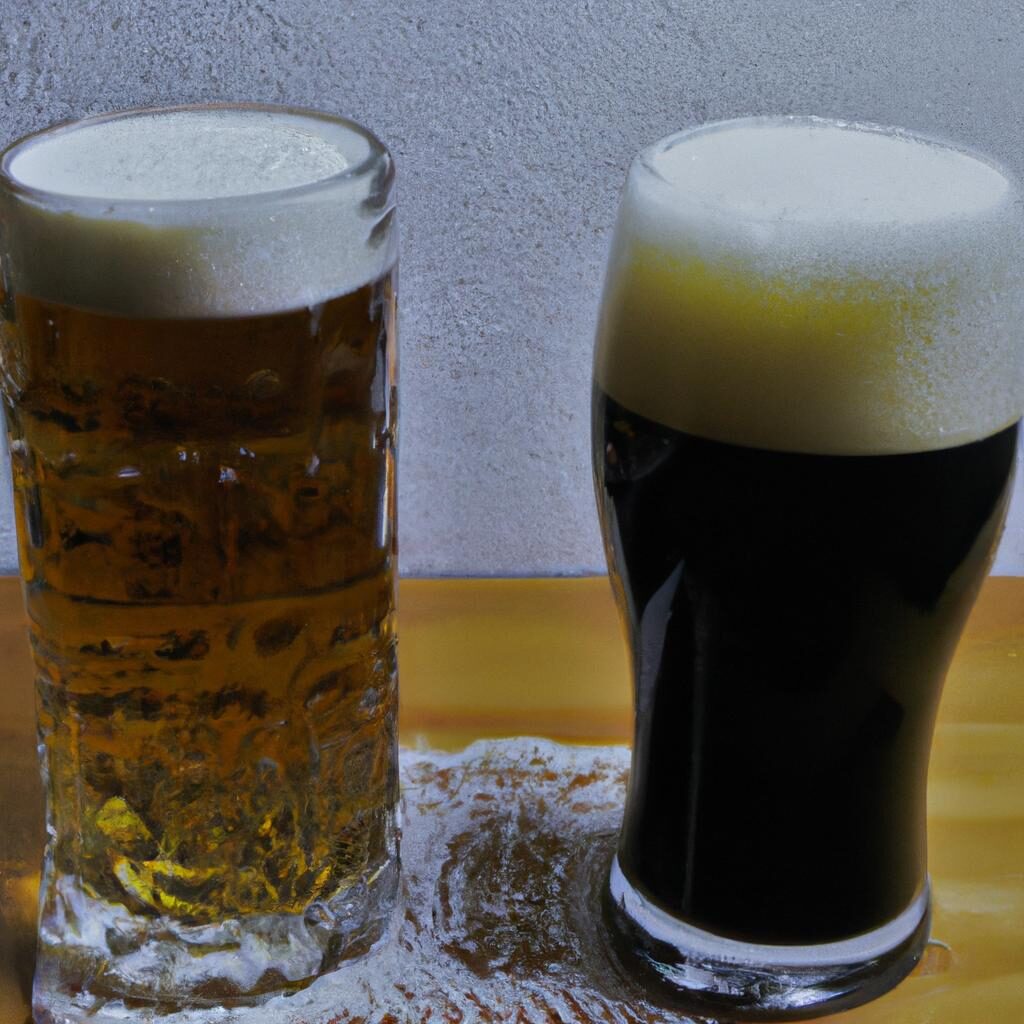One question that comes up quite often is, “Is a porter an ale or lager?” Since this is such a popular question, I thought it would be a great topic for a blog post.
So, let’s dive right in and answer this question: A porter is an ale, not a lager.
Now that we have the answer, you might be curious to know more about porters, ales, and lagers. Throughout the rest of this post, I’ll dive into more detail about each of these beer styles, including their history, brewing process, and some personal experiences I’ve had tasting these delicious brews.
Porters are Ales not Lagers
A porter is indeed a type of beer that belongs to the ale family, as opposed to being a lager. The distinction between ales and lagers lies in the different types of yeast used during the fermentation process and the temperature at which fermentation occurs.
Ales are fermented at warmer temperatures using top-fermenting yeast strains, known as Saccharomyces cerevisiae, which rise to the top of the fermentation vessel. This type of yeast typically ferments at temperatures between 15 to 24 degrees Celsius (59 to 75 degrees Fahrenheit). Ales generally have a faster fermentation process and are ready to drink relatively quickly.
On the other hand, lagers are fermented at cooler temperatures using bottom-fermenting yeast strains, known as Saccharomyces pastorianus, which settle at the bottom of the fermentation vessel.

Lager yeast ferments at temperatures between 7 to 13 degrees Celsius (45 to 55 degrees Fahrenheit), and the fermentation process is slower compared to ales. Lagers also typically undergo a longer conditioning period at lower temperatures, which contributes to their characteristic crisp and clean flavor profile.
Porter, a style of beer that originated in England in the 18th century, is traditionally classified as an ale. It is known for its dark color, robust malt character, and a balance of bitterness and sweetness. Porters were historically brewed with a combination of pale malts, brown malts, and roasted malts, which contribute to their deep brown to black appearance and rich flavors of chocolate, coffee, and caramel.
While there may be variations and modern interpretations of porters, the fundamental characteristic of being an ale remains consistent. However, it’s worth noting that the craft beer movement and evolving brewing techniques have led to experimentation and hybridization within beer styles.
Therefore, there might be examples of “lagered porters” or beers that incorporate elements of both ale and lager brewing methods, blurring the boundaries between the two categories. Nonetheless, the traditional and classic understanding is that porters are ales.
What Makes a Beer an Ale?
To understand why a porter is considered an ale, it’s important to know the differences between ales and lagers.
The primary distinction between the two lies in the type of yeast used during the fermentation process.

Ales are brewed using top-fermenting yeast strains, which ferment at warmer temperatures (usually between 60-75°F) and produce a wide range of flavors, from fruity to spicy.
Ales tend to have a more robust flavor profile and are generally more complex than lagers. Some common styles of ales include pale ales, IPAs, stouts, and, of course, porters.
The History of Porters
Porters have a rich history dating back to the 18th century in England. They were originally brewed as a blend of three different styles of beer: old ale, new ale, and a weaker beer known as “mild.” The name “porter” comes from the beer’s popularity among working-class porters in London, who favored its robust, flavorful character and relatively low alcohol content.
What Makes a Beer an Ale?
To understand why a porter is considered an ale, it’s important to know the differences between ales and lagers.
The primary distinction between the two lies in the type of yeast used during the fermentation process. Ales are brewed using top-fermenting yeast strains, which ferment at warmer temperatures (usually between 60-75°F) and produce a wide range of flavors, from fruity to spicy.
Ales tend to have a more robust flavor profile and are generally more complex than lagers. Some common styles of ales include pale ales, IPAs, stouts, and, of course, porters.
What Makes a Beer a Lager?
Lagers, on the other hand, are brewed using bottom-fermenting yeast strains. These strains ferment at cooler temperatures (usually between 45-55°F) and produce a much cleaner, crisper flavor profile.
This is because the cooler fermentation temperature allows for fewer esters and other byproducts to be produced during the fermentation process.
Lagers are often described as more “refreshing” and “easy-drinking” than ales, making them a popular choice for many casual beer drinkers. Some common styles of lagers include pilsners, helles, and Märzens.
The Brewing Process for Porters
As mentioned earlier, porters are brewed using top-fermenting yeast strains, making them a type of ale.
The brewing process for porters typically involves using darker malts, which give the beer its distinct dark color and rich, roasted flavor profile. Some porters also incorporate the use of adjuncts like chocolate or coffee to further enhance these flavors.
Porters are usually brewed with a moderate alcohol content (usually between 4-6% ABV), making them a great choice for those who enjoy a flavorful beer that isn’t too heavy or boozy.
Tasting a Porter: The Smell, Look, and Taste
My personal experience with porters has always been a delightful one. When poured into a glass, a porter will typically have a dark brown to almost black color, often with a thick, creamy tan head. The aroma can range from roasted malt and coffee to hints of chocolate or dark fruit.
As for the taste, porters tend to have a smooth, full-bodied mouthfeel with flavors of roasted malt, caramel, and chocolate. Some porters can also have a slightly bitter finish, which comes from the use of hops during the brewing process
Conclusion: A Porter is an Ale
To recap, a porter is indeed an ale, not a lager, due to the use of top-fermenting yeast strains during the brewing process. Now that you know the answer, here are 5 fun facts about porters and ales:
1. Porters originated in England in the 18th century and were popular among working-class porters in London.
2. Ales are brewed with top-fermenting yeast strains, which ferment at warmer temperatures and produce a wide range of flavors.
3. Lagers are brewed with bottom-fermenting yeast strains, which ferment at cooler temperatures and produce a cleaner, crisper flavor profile.
4. Porters are typically brewed with dark malts to create their rich, roasted flavor and dark color.
5. Porters have a moderate alcohol content, making them a great choice for those who enjoy flavorful beers that aren’t too heavy.
Next time you find yourself enjoying a delicious porter, you can impress your friends with your newfound knowledge of this delightful ale. Cheers!
FAQs
Can a porter be a lager?
Yes, a porter can be a lager if it is brewed using bottom-fermenting lager yeast and fermented at cooler temperatures typically associated with lager production. While porters are traditionally brewed as ales using top-fermenting yeast, a lager version is possible, resulting in a cleaner and smoother flavor profile compared to its ale counterpart.
What kind of beer is a porter?
A porter is a type of dark beer that originated in London in the 18th century. It is characterized by its dark brown or black color, medium to full body, and flavors of chocolate, caramel, and roasted malts.
Porters typically have a moderate alcohol content, ranging from 4% to 6.5% ABV, and a balanced bitterness from the use of hops. The style has evolved over time, with modern variations including robust porters, Baltic porters, and smoked porters, each with distinct flavor profiles and characteristics.
Is a porter a type of ale?
Yes, a porter is a type of ale. It is a dark, malty beer that originated in London in the 18th century. Porters are characterized by their use of roasted barley or malt, which gives them a rich, chocolatey flavor and dark brown to black color.
Is porter the same as ale?
No, porter is not the same as ale. Porter is a specific type of dark ale characterized by its roasted malt flavors, while ale is a broader category of beer that is fermented with top-fermenting yeast at warmer temperatures, resulting in a wide variety of flavors and styles, including porters, stouts, IPAs, and more.
Is a porter an ale or lager?
A porter is an ale, not a lager. It is a dark, malty beer with a rich, roasted flavor, originating from London in the 18th century. Ales, including porters, are brewed with top-fermenting yeast at warmer temperatures, which contributes to their distinct flavors and characteristics.




